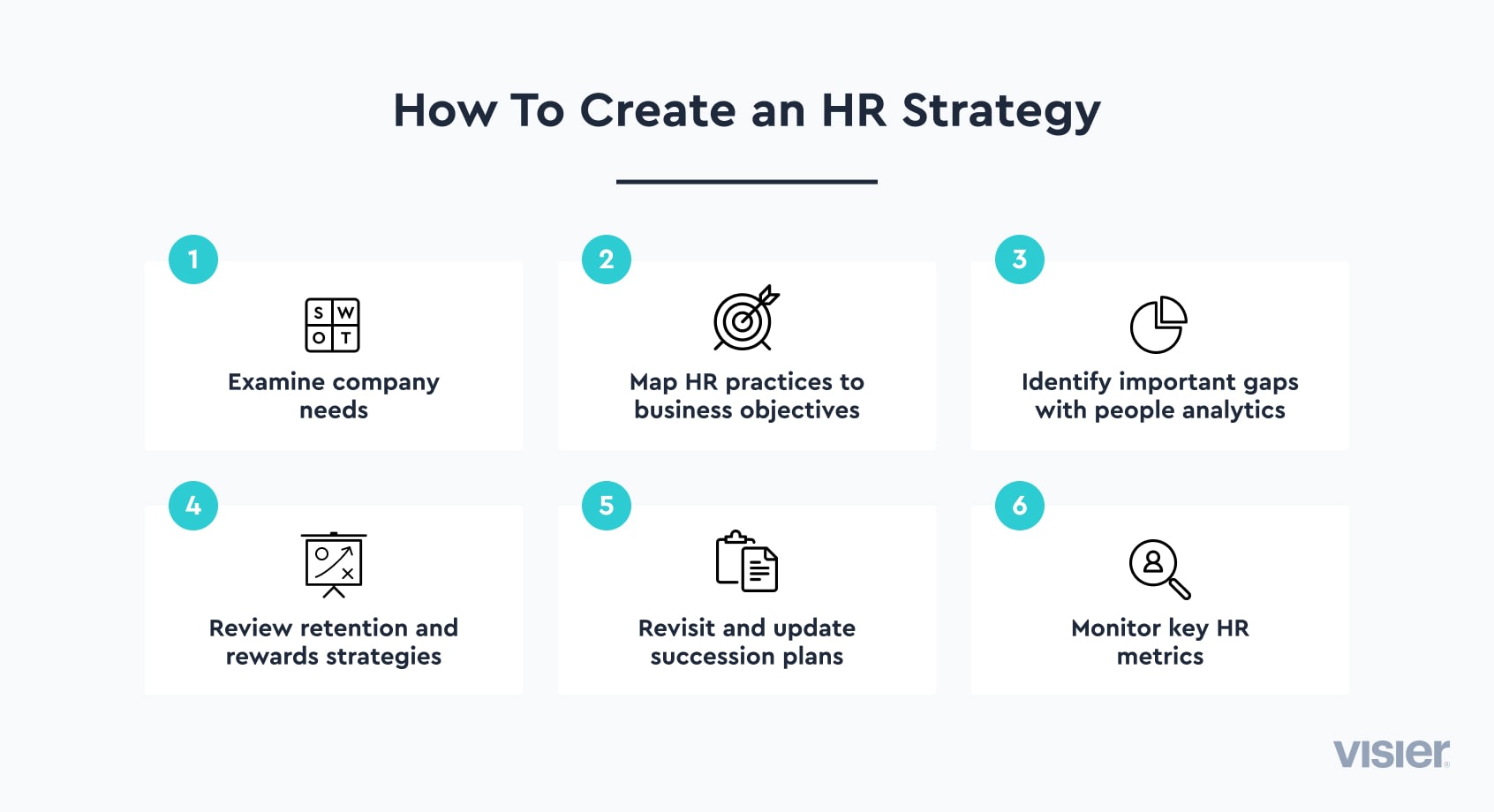HR STRATEGY
Complete Guide to a Successful HR Strategy
People data is part of every business. The key is using it effectively. An HR strategy allows you to create a plan that uses people-centric solutions to make data-informed decisions. It aligns HR practices with the company’s goal for a focused, clear, and common mission that ensures productivity, performance, and success.
Take a tour
Table of contents
What is an HR strategy?Why every business needs an HR strategy6 steps to creating an HR strategy3 examples of successful HR strategiesUse analytics to create an unbeatable HR strategyWhat is an HR strategy?
An HR strategy is an organization’s plan to address its primary concerns and achieve its business goals with people-centric solutions. The intent is to align HR practices with the company’s objectives while also attracting and maintaining top talent. Because of that, HR strategy typically focuses on talent management, recruitment, compensation, succession planning, and culture.
A successful human resource strategy will help businesses refine their people strategy and manage employees, ensuring diversity, inclusion, and equal opportunities for all.
Long-term, these strategies will keep the business competitive and guide it to obtain the best possible results. They will also assist a company’s journey towards Agile workforce planning, offering more flexibility, responsiveness, and better team collaboration.

Why every business needs an HR strategy
Strategic HR can make the difference between a successful business and one that struggles with high turnover rates, a difficult hiring process, low engagement, productivity, and more.
Picture this. Business A had an HR strategy from the very beginning. Their HR department takes part in the decision-making process and they look at metrics and people data whenever they approach a critical moment.
By doing so, they’re able to attract and maintain the right talent. Whenever an issue occurs, such as low engagement or an increase in absenteeism rates, they can act immediately to remediate the problem.
Business B, on the other hand, doesn’t have an HR strategy. They rarely analyze the market and don’t have a plan for attracting top talent. As a result, the time to productivity for new hires is often long. When they notice issues like a drop in productivity or high absenteeism rates, it can take a long time to find the root cause.
Having a strong HR strategy in place helps you avoid becoming Business B. Specifically, the benefits of an HR strategy include:
Improved employee engagement and satisfaction
Lower attrition rates
Attracting top talent
Increased productivity
Improved succession planning, reskilling, and upskilling programs
Reduced hiring costs

6 steps to creating an HR strategy
Creating an HR strategy can feel overwhelming if you don’t know where to start. Here are a few easy steps to guide you on your journey.
1. Perform a SWOT analysis
Before you start working on that HR strategy, you need to perform a thorough analysis of where your company is currently. What should you look at?
Strengths
Weaknesses
Opportunities
Threats
Also called a SWOT analysis, this process will show you where you are currently, what’s working, and what you should improve.
During this process, you’ll be looking at both past and present achievements and objectives. You’ll need to analyze various HR metrics, such as engagement, time to hire, or time to productivity.
2. Be clear about your business objectives
The superpower behind an HR strategy is its alignment with the business goals. But to get there, you first need to know what those goals are.
Look at what your business has to offer without forgetting past achievements. Then, ask yourself: where do we want to go next? Set clear objectives, make them SMART, and you’re well on your way to success.
3. Conduct an HR gap analysis
One of the primary goals of HR strategies is to align HR with business goals. Before you can do that, you need to identify any gaps that may exist.
This might include gaps in existing skills, headcount, or resources. Or, it could mean gaps in policies and people processes that you’ll need to scale to the next stage of growth.

4. Assess your retention strategy
Voluntary turnover comes with high costs. You lose time and money trying to find a replacement. An effective retention strategy is essential if you want to prevent this.
Regularly look at compensation, merit rewards, engagement, and other things that might drive employees to leave or help them stay.
Don’t forget about learning and development programs. They are often part of successful retention strategies, as employees are more likely to stay with a company that helps them grow and learn new things all the time.
5. Think about succession planning
No matter how good your retention strategies are, sometimes employees leave. Whether they do so to pursue a better opportunity, because they move to a different city, or simply retire, you need to be prepared for when that moment comes.
To do so, you need to answers questions like:
Who can fill other positions?
Is there something you can do to help them upskill or even reskill?
What are the positions for which you’d need to hire someone new?
Answering these questions will help you be prepared for when the inevitable happens so that you can fill the empty positions quickly and with minimal costs.
6. Monitor HR metrics
HR metrics are part of any successful HR strategy. We could go as far as saying monitoring them is a must for any successful business. They guide you in making data-informed decisions.
Why was productivity worse during the last quarter?
What is the best compensation strategy for your employees?
These are only some of the questions that are almost impossible to answer without monitoring the correct HR metrics.

3 examples of successful HR strategies
1. Diversity and inclusion
Employees appreciate diverse workplaces where they know everyone has an equal chance. A 2021 Glassdoor survey revealed that 67% of candidates look at the diversity in a company when considering a job offer. Creating a strategy that focuses on DEI could help you attract top performers and reduce voluntary attrition.
How to create this strategy depends on several factors, including the company’s culture, its goals, but also its sector. For instance, many tech companies have made it their goal to help more women enter this sector by supporting organizations such as Girls Who Code.
2. Onboarding focus
When talking about talent management, we tend to look more at the acquisition and retention programs. Forgetting about the onboarding phase is a huge mistake, though. A 2020 Digigate report shows that a negative onboarding experience makes it twice as likely for employees to seek out other opportunities in the near future.
Your onboarding strategy should be seamless. It should help employees feel welcome and support them on their path to learning the ins and outs of their new role.
Examples include being flexible about the lesson style—some may learn better by getting their hands dirty right away, while others may prefer to do some reading first. Whenever the role allows it, give your employees options to ensure the onboarding phase fits everyone’s learning style.
3. Employee wellness strategy
Engagement, satisfaction, and performance are the main topics when it comes to employees. But what about their well-being? When was the last time you wondered how fatigued or at risk of burnout your employees are?
Overworked employees eventually become disengaged and unhappy. They start performing poorly. And not necessarily because they don’t want to do a good job, but simply because they can’t.
This is where an HR strategy that puts employee wellness at the center comes in. Make sure people aren’t overworked and that they take enough breaks. Prioritize mental health, and offer resources for mindfulness, meditation, or yoga.
Like with onboarding, be sure to take into account the different preferences. Some may relax with meditation and yoga, but others might hate them and need something a little more dynamic.
If in doubt, offer short questionnaires to help understand what your employees want and how they’re feeling about their work-life balance.

Use analytics to create an unbeatable HR strategy
At the core of an impactful HR strategy is people data and people analytics. The insights you can glean enable you to answer critical questions about your workforce at every stage of the employee lifecycle so you can invest in what's working and improve areas that aren't with specificity.
Enhance your talent acquisition strategy to find the right people at the right time. Use people analytics to identify characteristics of quality hires, find top performers, improve recruiter efficiency, and use data-driven insights to boost the time to hire and productivity.
Understand which employees or cohorts are most at risk of leaving and resignation drivers. Create retention strategies that target the areas where you can truly make a difference so that you can decrease turnover rates and keep top performers. Build a more diverse workplace that's truly inclusive and safe for everyone. Get clarity on the next steps you need to take and align your people to drive genuine change.


![How to recession proof your business [resource card]](https://images.ctfassets.net/lbgy40h4xfb7/RKPbL5rhprXFMbSvEQc8h/2b20e9738f667765d6fcb7a1db05a35f/recession-proof-business.jpg?w=1200&h=700&fl=progressive&q=100&fm=jpg)